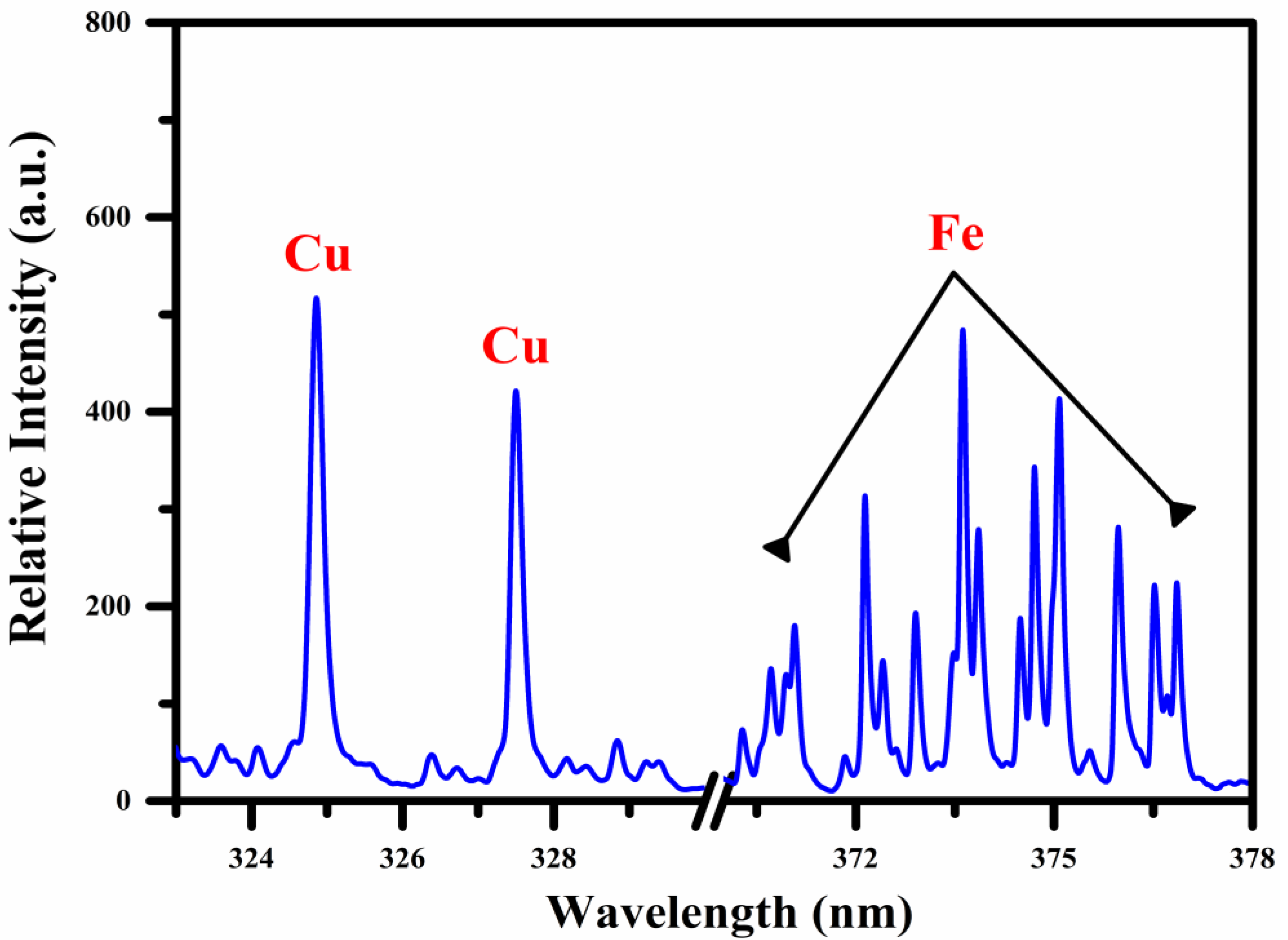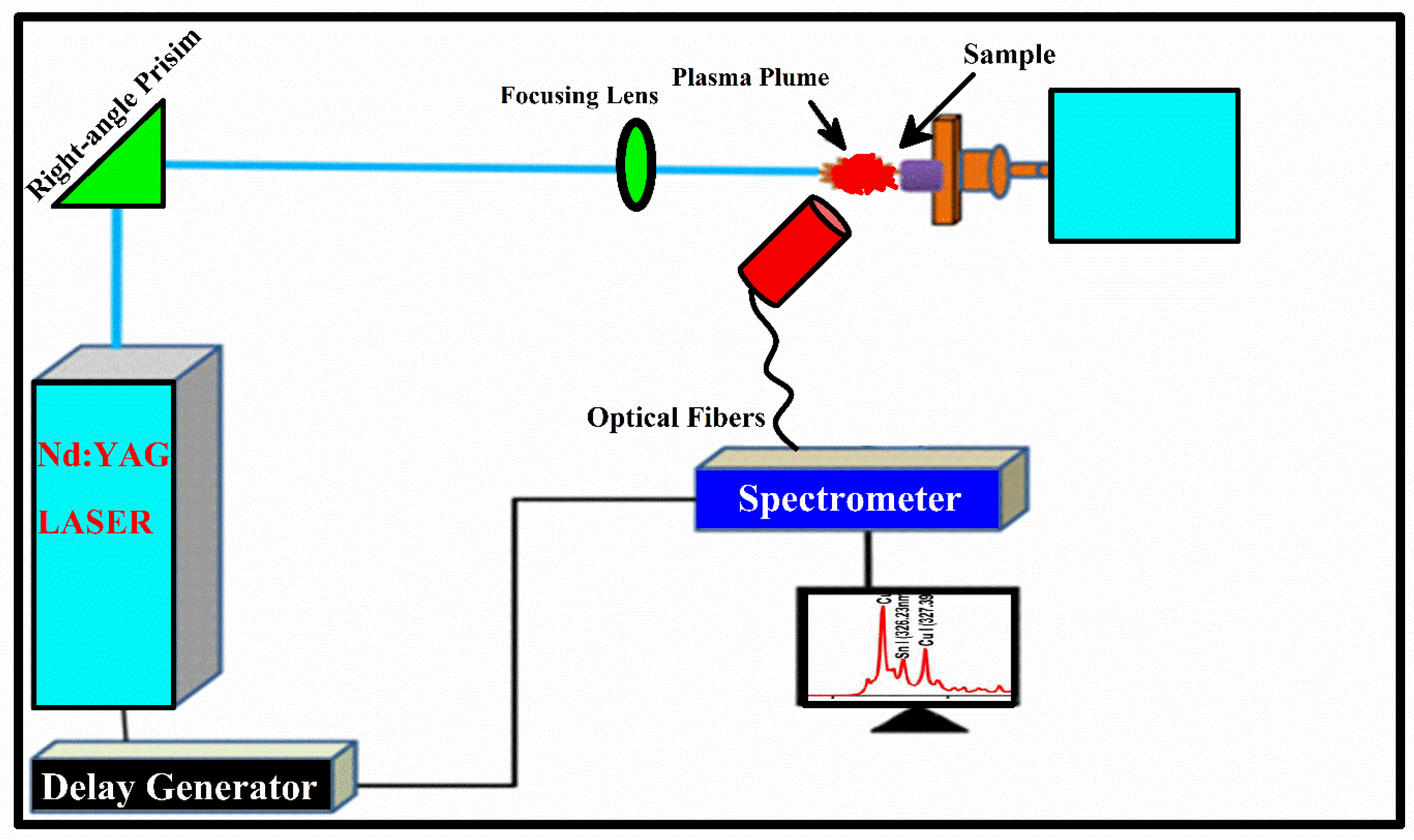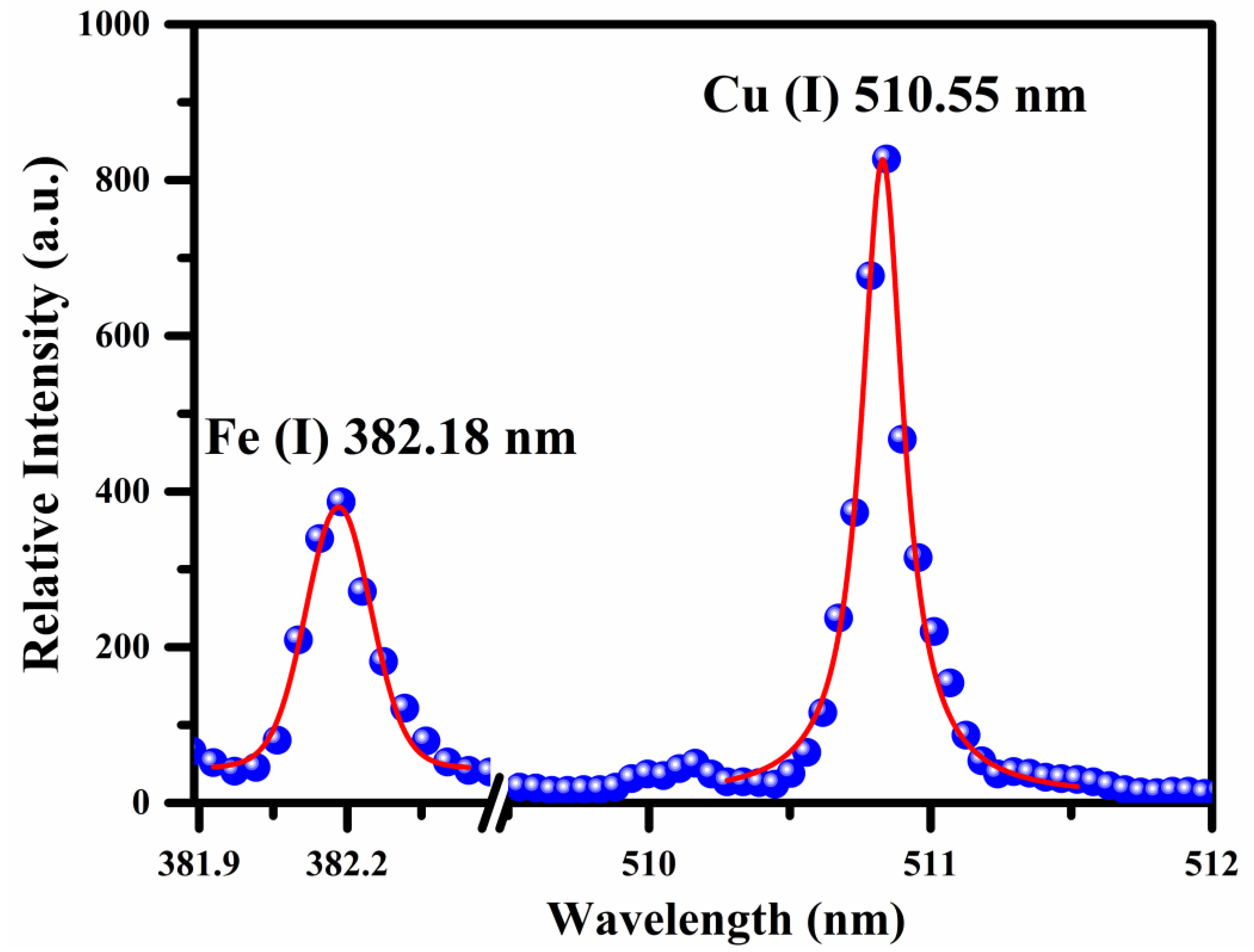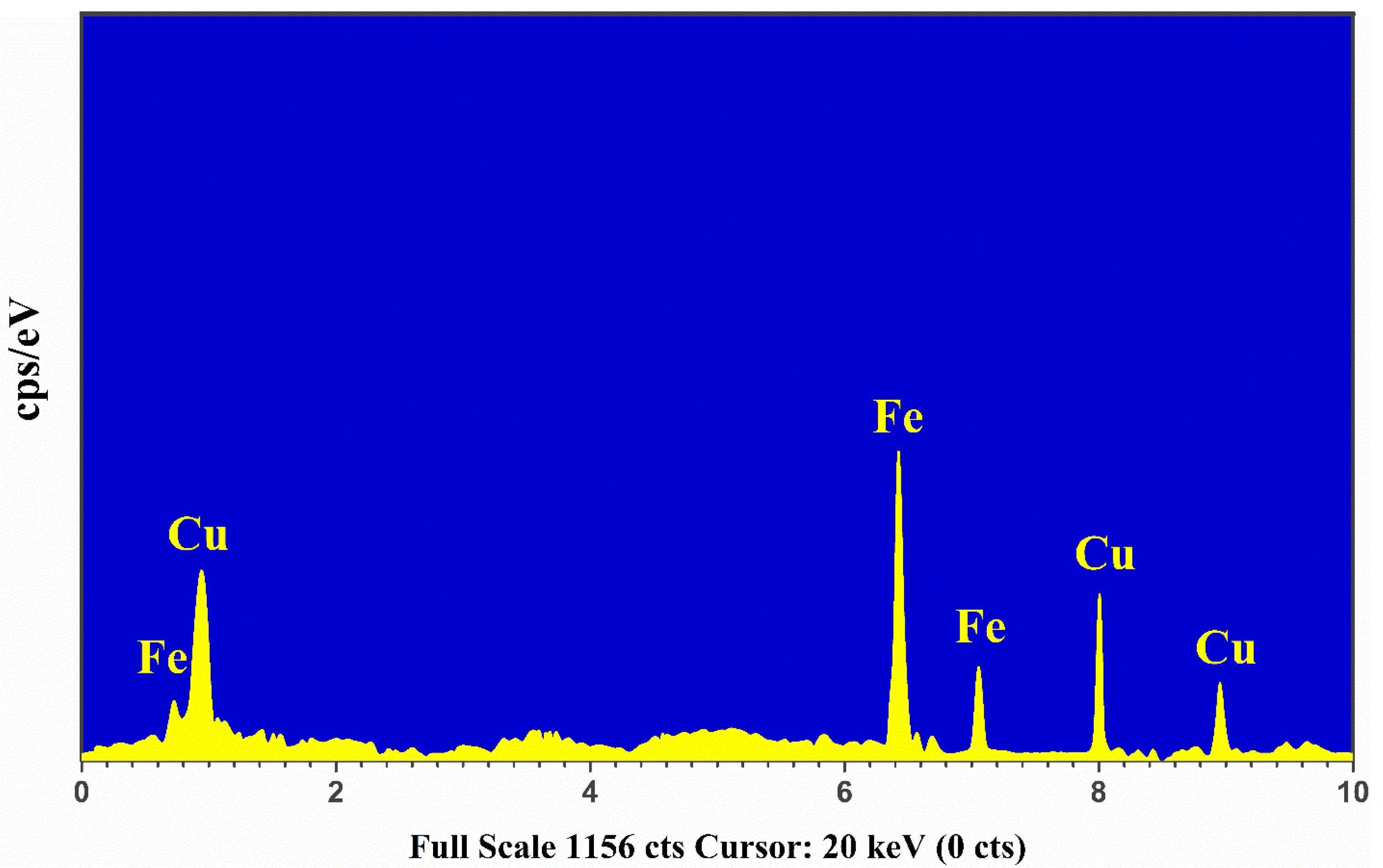Spectroscopical Characterization of Copper–Iron (Cu-Fe) Alloy Plasma Using LIBS, ICP-AES, and EDX
Abstract
1. Introduction
2. Experimental Setup
3. Results and Discussion
3.1. LIBS Emission Analyses
- For the calculation of plasma number density and plasma temperature, ground state transition lines are ignored;
- The transitions corresponding to lower energy below 6000 cm−1 are eliminated to reduce the self-absorption influence on the emission line;
- The transitions having a transition probability lesser than ≈106 s−1 are omitted to avoid the time intrusion between emission time and time related to the plasma variations.

3.2. Local Thermodynamical Equilibrium and Optically Thin Condition
3.3. Plasma Excitation Temperature
3.4. Electron Number Density
3.5. Calibration Free-LIBS
3.6. LIBS: Boltzmann Intercept Method
3.7. Energy Dispersive X-ray (EDX) Studies
3.8. ICP-AES Analysis
3.9. Comparative Analyses
4. Conclusions
Author Contributions
Funding
Data Availability Statement
Acknowledgments
Conflicts of Interest
References
- Noll, R.; Fricke-Begemann, C.; Connemann, S.; Meinhardt, C.; Sturm, V. LIBS analyses for industrial applications–an overview of developments from 2014 to 2018. J. Anal. At. Spectrom. 2018, 33, 945–956. [Google Scholar] [CrossRef]
- Smith, W.F.; Hashemi, J.; Presuel-Moreno, F. Foundations of Materials Science and Engineering; McGraw-Hill: New York, NY, USA, 2006; Volume 509. [Google Scholar]
- Belmont. Adding Iron into Copper Alloys: Properties and Advantages. Available online: https://www.belmontmetals.com/adding-iron-into-copper-alloys-properties-and-advantages/ (accessed on 6 February 2023).
- American Society For Testing Materials (Revised Annually). “Copper and Copper Alloys.” Annual Book of ASTM Standards; ASTM International: West Conshohocken, PA, USA, 2004; Volume 2.1. [Google Scholar]
- Breedis, J.F.; Caron, R.N. “Copper Alloys (Wrought).” Kirk-Othmer Encyclopedia of Chemical Technology, 4th ed.; John Wiley & Sons, Inc.: Hoboken, NJ, USA, 1993; Volume 7, pp. 429–473. [Google Scholar]
- Babilas, R.; Bajorek, A.; Spilka, M.; Radoń, A.; Łoński, W. Structure and corrosion resistance of Al–Cu–Fe alloys. Prog. Nat. Sci. Mater. Int. 2020, 30, 393–401. [Google Scholar] [CrossRef]
- Huttunen-Saarivirta, E. Microstructure, fabrication and properties of quasicrystalline Al–Cu–Fe alloys: A review. J. Alloys Compd. 2004, 363, 154–178. [Google Scholar] [CrossRef]
- Laplanche, G.; Bonneville, J.; Joulain, A.; Gauthier-Brunet, V.; Dubois, S. Mechanical properties of Al–Cu–Fe quasicrystalline and crystalline phases: An analogy. Intermetallics 2014, 50, 54–58. [Google Scholar] [CrossRef]
- Ciucci, A.; Corsi, M.; Palleschi, V.; Rastelli, S.; Salvetti, A.; Tognoni, E. New procedure for quantitative elemental analysis by laser-induced plasma spectroscopy. Appl. Spectrosc. 1999, 53, 960–964. [Google Scholar] [CrossRef]
- Griem, H.R. Principles of Plasma Spectroscopy; Cambridge University Press: Cambridge, UK, 1997. [Google Scholar]
- Cremers, D.A.; Radziemski, L.J. Handbook of Laser-Induced Breakdown Spectroscopy; John Wiley & Sons: Hoboken, NJ, USA, 2013. [Google Scholar]
- Fichet, P.; Menut, D.; Brennetot, R.; Vors, E.; Rivoallan, A. Analysis by laser-induced breakdown spectroscopy of complex solids, liquids, and powders with an echelle spectrometer. Appl. Opt. 2003, 42, 6029–6035. [Google Scholar] [CrossRef]
- Iqbal, J.; Alrabdi, T.A.; Fayyaz, A.; Asghar, H.; Shah, S.K.H.; Naeem, M. Elemental study of Devarda’s alloy using calibration free-laser induced breakdown spectroscopy (CF–LIBS). Laser Phys. 2023, 33, 036001. [Google Scholar] [CrossRef]
- Gomba, J.M.; D’Angelo, C.; Bertuccelli, D.; Bertuccelli, G. Spectroscopic characterization of laser induced breakdown in aluminium–lithium alloy samples for quantitative determination of traces. Spectrochim. Acta Part B At. Spectrosc. 2001, 56, 695–705. [Google Scholar] [CrossRef]
- Mohamed, W.T.Y. Improved LIBS limit of detection of Be, Mg, Si, Mn, Fe and Cu in aluminum alloy samples using a portable Echelle spectrometer with ICCD camera. Opt. Laser Technol. 2008, 40, 30–38. [Google Scholar] [CrossRef]
- Goode, S.R.; Morgan, S.L.; Hoskins, R.; Oxsher, A. Identifying alloys by laser-induced breakdown spectroscopy with a time-resolved high resolution echelle spectrometer. Presented at the 2000 Winter Conference on Plasma Spectrochemistry, Fort Lauderdale, FL, USA, January 10–15, 2000. J. Anal. At. Spectrom. 2000, 15, 1133–1138. [Google Scholar] [CrossRef]
- Ismail, M.A.; Imam, H.; Elhassan, A.; Youniss, W.T.; Harith, M.A. LIBS limit of detection and plasma parameters of some elements in two different metallic matrices. J. Anal. At. Spectrom. 2004, 19, 489–494. [Google Scholar] [CrossRef]
- Castro, J.P.; Pereira-Filho, E.R. Twelve different types of data normalization for the proposition of classification, univariate and multivariate regression models for the direct analyses of alloys by laser-induced breakdown spectroscopy (LIBS). J. Anal. At. Spectrom. 2016, 31, 2005–2014. [Google Scholar] [CrossRef]
- Shakeel, H.; Haq, S.U.; Aisha, G.; Nadeem, A. Quantitative analysis of Al-Si alloy using calibration free laser induced breakdown spectroscopy (CF-LIBS). Phys. Plasmas 2017, 24, 063516. [Google Scholar] [CrossRef]
- Ali, I.; Pan, Y.; Jamil, Y.; Shah, A.A.; Amir, M.; Al Islam, S.; Fazal, Y.; Chen, J.; Shen, Z. Comparison of copper-based Cu-Ni and Cu-Fe nanoparticles synthesized via laser ablation for magnetic hyperthermia and antibacterial applications. Phys. B Condens. Matter 2023, 650, 414503. [Google Scholar] [CrossRef]
- Ahmed, N.; Shahida, S.; Kiani, S.M.; Razzaq, M.I.; Hameed, M.U.; Iqbal, S.M.Z.; Abbasi, S.A.; Rafique, M.; Baig, M.A. Analysis of an Iron-Copper Alloy by Calibration-Free Laser-Induced Breakdown Spectroscopy (CF-LIBS) and Inductively Coupled Plasma–Mass Spectrometry (ICP-MS). Anal. Lett. 2022, 55, 2239–2250. [Google Scholar] [CrossRef]
- Alrebdi, T.A.; Fayyaz, A.; Asghar, H.; Elaissi, S.; Maati, L.A.E. Laser Spectroscopic Characterization for the Rapid Detection of Nutrients along with CN Molecular Emission Band in Plant-Biochar. Molecules 2022, 27, 5048. [Google Scholar] [CrossRef]
- Alrebdi, T.A.; Fayyaz, A.; Ben Gouider Trabelsi, A.; Asghar, H.; Alkallas, F.H.; Alshehri, A.M. Vibrational Emission Study of the CN and C2 in Nylon and ZnO/Nylon Polymer Using Laser-Induced Breakdown Spectroscopy (LIBS). Polymers 2022, 14, 3686. [Google Scholar] [CrossRef]
- Iqbal, J.; Mahmood, S.; Tufail, I.; Asghar, H.; Ahmed, R.; Baig, M.A. On the use of laser induced breakdown spectroscopy to characterize the naturally existing crystal in Pakistan and its optical emission spectrum. Spectrochim. Acta Part B At. Spectrosc. 2015, 111, 80–86. [Google Scholar] [CrossRef]
- Fayyaz, A.; Asghar, H.; Alshehri, A.M.; Alrebdi, T.A. LIBS assisted PCA analysis of multiple rare-earth elements (La, Ce, Nd, Sm, and Yb) in phosphorite deposits. Heliyon 2023, 9, e13957. [Google Scholar] [CrossRef]
- ASD. NIST Atomic Spectra Database Lines Form. Available online: https://physics.nist.gov/PhysRefData/ASD/lines_form.html (accessed on 6 February 2023).
- Konjević, N.; Lesage, A.; Fuhr, J.R.; Wiese, W.L. Experimental Stark widths and shifts for spectral lines of neutral and ionized atoms (a critical review of selected data for the period 1989 through 2000). J. Phys. Chem. Ref. Data 2002, 31, 819–927. [Google Scholar] [CrossRef]
- Vassileva, E.; Furuta, N. Application of iminodiacetate chelating resin muromac A-1 in on-line preconcentration and inductively coupled plasma optical emission spectroscopy determination of trace elements in natural waters. Spectrochim. Acta Part B At. Spectrosc. 2003, 58, 1541–1552. [Google Scholar] [CrossRef]
- Lesage, A.; Lebrun, J.L.; Richou, J. Temperature dependence of Stark parameters for Fe I lines. Astrophys. J. 1990, 360, 737–740. [Google Scholar] [CrossRef]
- Griem, H.R. Plasma Spectroscopy; McGraw Hill: New York, NY, USA, 1964. [Google Scholar]
- Miziolek, A.; Palleschi, W.V.; Schechter, I. Laser Induced Breakdown Spectroscopy-Fundamentals198 and Applications; Cambridge University Press: Cambridge, UK, 2006. [Google Scholar]
- Cremers, D.A.; Radziemski, L. Handbook of Laser Induced Breakdown Spectroscopy; Wiley: New York, NY, USA, 2006. [Google Scholar]
- Aragon, C.; Aguilera, J.A. Determination of the local electron number density in laser-induced plasmas by Stark-broadened profiles of spectral lines: Comparative results from Hα, Fe I and Si II lines. Spectrochim. Acta Part B At. Spectrosc. 2010, 65, 395–400. [Google Scholar] [CrossRef]
- Noll, R. Laser-Induced Breakdown Spectroscopy—Fundamentals and Applications; Springer: Berlin/Heidelberg, Germany, 2012. [Google Scholar]
- Unnikrishnan, V.K.; Alti, K.; Kartha, V.B.; Santhosh, C.; Gupta, G.P.; Suri, B.M. Measurements of plasma temperature and electron density in laser-induced copper plasma by time-resolved spectroscopy of neutral atom and ion emissions. Pramana 2010, 74, 983–993. [Google Scholar] [CrossRef]





| Element | λ (nm) | Accuracy | Intensity (a.u.) | Experimental Ratio | Theoretical Ratio | |||
|---|---|---|---|---|---|---|---|---|
| Cu l | 515.32 | 6.0 × 107 | C+ | 4 | 1079 | 6.19 | 0.532 | 0.539 |
| 521.82 | 7.5 × 107 | C+ | 6 | 2028 | ||||
| Fe l | 372.13 | 6.7 × 106 | B | 3 | 61.5 | 5.82 | 0.586 | 0.536 |
| 382.18 | 7.3 × 106 | B | 5 | 104.9 | 5.85 |
| Element | Wavelength λ (nm) | Transition Probability Ak (s−1) | Accuracy | Statistical Weight gk | Upper Energy Level Ek (cm−1) |
|---|---|---|---|---|---|
| Fe l | 358.26 | 2.44 × 105 | C | 7 | 47,693.2 |
| 414.61 | 3.78 × 105 | C+ | 11 | 48,231.3 | |
| 418.95 | 2.70 × 106 | D | 7 | 53,661.1 | |
| 426.42 | 1.62 × 106 | C+ | 7 | 50,611.3 | |
| 470.74 | 2.92 × 105 | C | 5 | 44,183.6 | |
| 561.52 | 2.39 × 105 | C | 5 | 38,678.0 | |
| Cu l | 406.26 | 2.10 × 107 | C | 6 | 55,391.3 |
| 458.69 | 3.20 × 107 | C+ | 6 | 62,948.3 | |
| 465.11 | 3.80 × 107 | C+ | 8 | 62,403.3 | |
| 515.32 | 6.00 × 107 | C+ | 4 | 49,935.2 | |
| 521.82 | 7.50 × 107 | C+ | 6 | 49,942.0 | |
| 570.02 | 2.40 × 105 | C+ | 4 | 30,783.7 |
| Elements | |
|---|---|
| Composition wt.% ± RSD Using CF-LIBS | |
| Cu | 18.09 ± 1.26 |
| Fe | 81.91 ± 5.73 |
| Elements | CF-LIBS ± RSD | Boltzmann Intercept Method ± RSD | EDX ± RSD | ICP-AES ± RSD | Standard |
|---|---|---|---|---|---|
| Cu | 18.09 ± 1.26 | 19.11 ± 0.95 | 22.21 ± 1.33 | 21.09 ± 0.84 | 20 |
| Fe | 81.91 ± 5.73 | 80.89 ± 4.04 | 77.79 ± 4.66 | 78.91 ± 3.15 | 80 |
Disclaimer/Publisher’s Note: The statements, opinions and data contained in all publications are solely those of the individual author(s) and contributor(s) and not of MDPI and/or the editor(s). MDPI and/or the editor(s) disclaim responsibility for any injury to people or property resulting from any ideas, methods, instructions or products referred to in the content. |
© 2023 by the authors. Licensee MDPI, Basel, Switzerland. This article is an open access article distributed under the terms and conditions of the Creative Commons Attribution (CC BY) license (https://creativecommons.org/licenses/by/4.0/).
Share and Cite
Fayyaz, A.; Iqbal, J.; Asghar, H.; Alrebdi, T.A.; Alshehri, A.M.; Ahmed, W.; Ahmed, N. Spectroscopical Characterization of Copper–Iron (Cu-Fe) Alloy Plasma Using LIBS, ICP-AES, and EDX. Metals 2023, 13, 1188. https://doi.org/10.3390/met13071188
Fayyaz A, Iqbal J, Asghar H, Alrebdi TA, Alshehri AM, Ahmed W, Ahmed N. Spectroscopical Characterization of Copper–Iron (Cu-Fe) Alloy Plasma Using LIBS, ICP-AES, and EDX. Metals. 2023; 13(7):1188. https://doi.org/10.3390/met13071188
Chicago/Turabian StyleFayyaz, Amir, Javed Iqbal, Haroon Asghar, Tahani A. Alrebdi, Ali M. Alshehri, Waqas Ahmed, and Nasar Ahmed. 2023. "Spectroscopical Characterization of Copper–Iron (Cu-Fe) Alloy Plasma Using LIBS, ICP-AES, and EDX" Metals 13, no. 7: 1188. https://doi.org/10.3390/met13071188
APA StyleFayyaz, A., Iqbal, J., Asghar, H., Alrebdi, T. A., Alshehri, A. M., Ahmed, W., & Ahmed, N. (2023). Spectroscopical Characterization of Copper–Iron (Cu-Fe) Alloy Plasma Using LIBS, ICP-AES, and EDX. Metals, 13(7), 1188. https://doi.org/10.3390/met13071188







